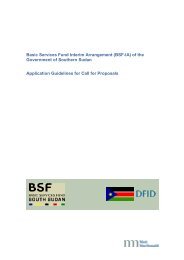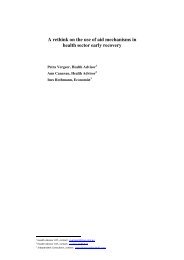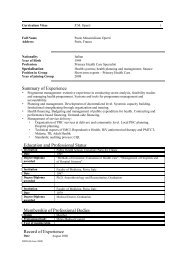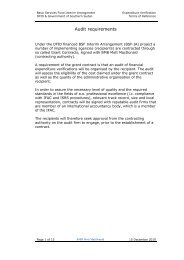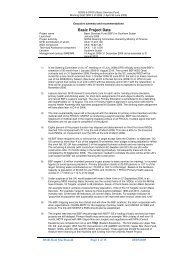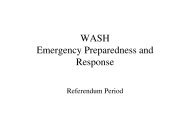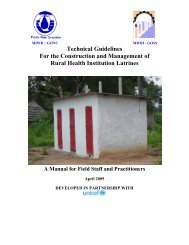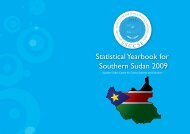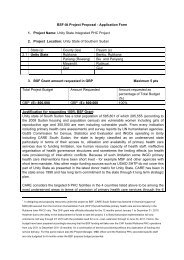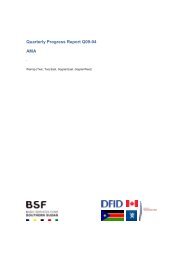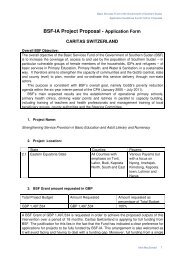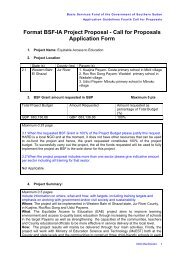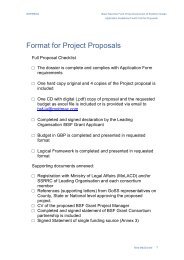CMSI BSF-IA Proposal - Basic Services Fund SOUTH SUDAN
CMSI BSF-IA Proposal - Basic Services Fund SOUTH SUDAN
CMSI BSF-IA Proposal - Basic Services Fund SOUTH SUDAN
- No tags were found...
You also want an ePaper? Increase the reach of your titles
YUMPU automatically turns print PDFs into web optimized ePapers that Google loves.
<strong>Basic</strong> <strong>Services</strong> <strong>Fund</strong> of the Government of Southern SudanApplication Guidelines Fourth Call for <strong>Proposal</strong>sFormat <strong>BSF</strong>-<strong>IA</strong> Project <strong>Proposal</strong> - Call for <strong>Proposal</strong>sApplication FormCMS IRELANDIMPORTANT:• Fill out the form below and answer each question separately in this format.• Use margins of 2.5 cm (1 inch) and arial font size 11 point. The maximum allocatedspace per section is based on this margin and font size.• Where reference is made to population data, applicants must use the figures from the“5 th Sudan housing and population census 2008”.Overall <strong>BSF</strong> Objective:The overall objective of the <strong>Basic</strong> <strong>Services</strong> <strong>Fund</strong> of the Government of Southern Sudan (<strong>BSF</strong>)is to increase the coverage of, access to and use by the population of Southern Sudan – inparticular vulnerable groups of female members of the households, IDPs and refugees – ofbasic services in Primary Education, Primary Health, and Water & Sanitation, in a sustainableway. It therefore aims to strengthen the capacity of communities and the GoSS (central, stateand county level) to plan, monitor and co-ordinate this service delivery through non-stateactors.This purpose is consistent with <strong>BSF</strong>’s overall goal, namely GoSS’s poverty reduction agendawithin the six-year interim period of the CPA (January 2005 – July 2011).<strong>BSF</strong>’s main expected results are the establishment of operational primary schools, primaryhealth clinics, drinking water points and latrines in parallel to capacity building, includingtraining of teachers and health professionals and management training of local beneficiarygroups, county authorities and the Steering Committee.1. Project Name: Category 1: Education is Life (EIL)Category 2: Continuation of Health, Education and Rural Transformation(HEART)2. Project Location: Central Equatoria and Western Equatoria StatesState (s) County (ies) Payam (s)Category 1 – EIL2.1 Western Equatoria Ibba Nabanga & environs2.2 Western Equatoria Maridi Maridi & Marurundi2.3 Central Equatoria Kajo-Keji Liwolo & environs2.4 Central Equatoria Lainya Wuji & other PayamsCategory 2 – HEART continuation2.5 Central Equatoria Yei River Otogo, Tore, Mugwoand Yei2.6 Central Equatoria Morobo Panyana & Morobo2.7 Central Equatoria Lainya Lainya and otherPayams identifiedMott MacDonald 1
<strong>Basic</strong> <strong>Services</strong> <strong>Fund</strong> of the Government of Southern SudanApplication Guidelines Fourth Call for <strong>Proposal</strong>s3. <strong>BSF</strong> Grant amount requested in GBP Maximum 5 ptsTotal Project Budget Amount Requested Amount requested aspercentage of Total Budget(%)GBP. £1,445,350 GBP £1,445,350 100%3.1 When the requested <strong>BSF</strong> Grant is 100% of the Project Budget please justify this request. 3.2 When the requested <strong>BSF</strong>Grant is less than 100% please name source(s) of this additional funding and specify what arrangements are in place in case thisfunding cannot be realised; consequences of this event must be specified3.2 When the requested <strong>BSF</strong> Grant is less than 100%, please specify the approximate timing of spending the <strong>BSF</strong> grant.3.3 When the project proposal includes more than one sector please give indicative amount per sector including all training forthat sector. Maximum 0.25 page3.1 CMS Ireland is seeking a grant for 100% of the funds required. Currently it has no otherdonors for basic services funding. CMS Ireland has the proven international track record ofefficient delivery from other donors including Irish Aid, UNDP Sudan Recovery <strong>Fund</strong>, ARDF,Churches and CoIBDA across 8 Counties in Sudan. It also has the capacity, through strongSudanese consortium partners, to deliver the programme.3.3 The split between sectors is as follows:Education £1,223,040Water and sanitation £142,310Continuation of the health element of the HEART project: £80,0004. Project Summary:Maximum 0.5 pages.Include information on where, what and how, with targets, including training targets and emphasis on working with governmentand/or civil society and sustainability.Category 1. EIL.A summary of the Education and WASH elements of this proposal, include constructing 2Primary Schools by September 2011 and 2, 3-classroom blocks in Kajo-Keji County byDecember 2010; 1 Primary School in Lainya County by March 2011; 1 Primary School inMaridi County by June 2011; 1 Primary School in Ibba County by June 2011. We will train 20teachers identified by the Counties by December 2011; arrange training for Parent TeacherAssociations (PTA) for the new schools by September 2011 and supply the new PrimarySchools with teaching materials by September 2011. We will work closely with the CountyEducation Department (CED) and the schools will be handed onto our partners, the PTA’sand Education authorities for them to sustain, paying teachers.Category 2. HEART continuationThis proposal seeks funding to continue vital mobile health services initially funded in <strong>BSF</strong>Round 3, including salaries, medicines and running costs. CMS Ireland established a mobileclinic working from the Martha Primary Health Care Centre (PHCC) in Yei. Working closelywith the County Health Department (CHD) to identify target villages, it made weekly visits tovillages where the County-run Primary Health Care Unit’s (PHCU) offered no or minimalservice. It has been acknowledged and appreciated by the CHD for offering much-neededsupport and capacity building to rural PHCU’s. Patient numbers are high at 2,500 per quarterand ongoing training on a 6 monthly basis will be given to Village Health Committees (VHC).We will also build the capacity of Community Health Workers (CHW). In Lainya County, weestablished a motorcycle health outreach service to 3 Internally Displaced People (IDP)camps, which had no medical facilities. The CHD has greatly appreciated this service and weare seeking ongoing support for salaries, medicines and running costs to ensure futuresustainability. We will drill 3 boreholes and provide community pit latrines in new locationsMott MacDonald 2
<strong>Basic</strong> <strong>Services</strong> <strong>Fund</strong> of the Government of Southern SudanApplication Guidelines Fourth Call for <strong>Proposal</strong>sserved by the primary health mobile outreach service by July 2011. We will collaborate with arange of health NGO’s to provide added value services.5. Project Objective:Maximum 0.25 pages.Objective must be Specific, Measurable, Attainable, Realistic and Time-bound (SMART)Objective 1: To bring measurable improvements to the educational experience ofapproximately 3,500 children and indirectly more by constructing 5 Primary Schools in 4counties. To build 2, 3-classroom blocks in Kajo-Keji County. To provide full-time training for20 teachers, training for 100 PTA members, teaching resources and scholastic materials,drilling 5 boreholes and constructing 40 latrines by December 2011.Objective 2: Provide weekly mobile health services to 8 rural communities totalling c.10,000people in 3 Counties by December 2011. The service will produce tangible health carebenefits to meet GoSS priorities such as improving immunisation rates, providing qualityantenatal care following MoH guidelines, increased child survival and WatSan. We will drill 3boreholes and provide community pit latrines to new locations and ongoing training to buildthe capacity of 10 local CHW's, TBAs, and EPI staff. Village Health Committees will receivethree, 2-day training sessions by December 2011.6. Justification: Maximum 40 ptsMaximum 2 pages6.1 Relevance of the project to <strong>BSF</strong>’s overall objectives.6.2 What GoSS sector priorities as described in the application guidelines will the project address?6.3 What underserved / priority counties as identified by GoSS and described in the application guidelines are targeted?6.4 The different target groups and beneficiaries of the project and the specific needs and constraints of these groups.6.5 The extent to which women and girls are specifically targeted.6.1 This proposal is relevant to the <strong>BSF</strong> overall objectives of improved coverage of andaccess to basic education, primary health and water and sanitation services as an essentialstep in rebuilding the lives of communities recovering from prolonged periods of conflict.Because it is in fact cross-sectoral, it covers all 3 main <strong>BSF</strong> objectives.6.2 It also addresses the 3 GoSS priorities within the 3 <strong>BSF</strong> sectors for basic services: toprovide free primary health care to improve the health status of the population; to provideequitable access to basic education and to increase access to safe water and sanitation. Theproject will target GoSS water and sanitation priorities including access to clean water; theconstruction of latrines; drilling boreholes and increased awareness. CMS Ireland will alsotarget the MoH priorities as listed below under the Category 2 HEART continuation.6.3 While the project includes 2 GoSS priority counties of Kajo-Keji and Morobo in CentralEquatoria State (CES), the guideline clearly states that all counties under GoSSadministration are eligible for <strong>BSF</strong>-<strong>IA</strong> funding. The 2 <strong>BSF</strong> categories of this project cover 6counties across 2 States again in line with the GoSS and <strong>BSF</strong> guidelines – Kajo-Keji, Lainya,Yei, Morobo in CES and LRA affected counties of Maridi and Ibba in Western Equatoria State(WES).Category 1 - EIL6.2 This intervention seeks to address the GoSS MoEST priorities including in-service teachereducation; working through the CES system; training teachers in a local TTI; support fortraining materials and working with the MoEST. We will also collaborate with the authorities inthe selection of teachers for training, monitor the training and specifically target trainingtowards female teachers. We will also comply with many of the other MoEST prioritiesMott MacDonald 3
<strong>Basic</strong> <strong>Services</strong> <strong>Fund</strong> of the Government of Southern SudanApplication Guidelines Fourth Call for <strong>Proposal</strong>sincluding the Primary School construction guidelines on design, WatSan provision etc.; theconditions and cross-cutting construction issues including site selection criteria as well as thecriteria for teaching materials and PTA information and capacity building issues.6.3 The project will specifically target the MoEST priority county of Kajo-Keji withapproximately 50% of its education expenditure planned for this county.6.4 This project aims to meet the criteria for 5 of the 6 <strong>BSF</strong>-<strong>IA</strong> education target groups:construct child friendly schools based on MoEST criteria; provide general in-service trainingand course specific training for teachers and distribute learning materials. The beneficiarygroups will include uneducated rural males and females. One of the major specific needs andconstraints of these groups are the difficulty of releasing females from their household dutiesto attend school. While CMS Ireland has identified 4 counties in which to build new PrimarySchools, nearly 50% of its programme will be carried out in the priority county of Kajo-Keji,where it is proposed to build 2 complete Primary Schools and provide 2 other rural schoolswith additional classrooms. The other 3 counties also have a pressing need for PrimarySchools and have all been affected by tens of thousands of people being displaced due toLRA activity within the last two years. This proposal meets the GoSS objective of trainingmore Primary School Teachers and we propose to train 20 additional teachers on full timecourses at the Yei Teacher Training College (YTTC) during the project timeframe. Setting upand training an active and enthusiastic PTA will also be a priority of the project.6.5 There will be a positive discrimination approach and a specific emphasis on encouraginggirls to attend school. The project will also focus on training an equal number of male andfemale teachers where they are available and whenever possible. We will also seek to ensurethat, by holding the training close to the community, a higher proportion of women can betrained for the PTA’s than would otherwise be the case with centralised training.Category 2 – HEART continuation6.2 CMS Ireland will continue to work to the target priority indicators identified in the GoSSMoH BPHS in particular the following:• Community Participation by using health committees to actively involve the community(particularly women) in prevention of disease including WatSan provision (MDG 3).• Providing an enhanced level of healthcare to within easy reach of 5 villages in need ofhealth care provision in Yei and Morobo Counties; and of 3 IDP camps in Lainya County.• Working with village midwives in Yei and Morobo County to teach them increased levelsof antenatal care and early identification of those needing specialist help and whenpossible transporting them to hospital (MDG 5).• HIV/AIDS counselling testing and education (MDG 6).• Working with CHW’s to raise their capacity by having staff on the mobile unit with higherskills and greater experience.• Continuing to train VHC’s every 6 months to increase their skills.• Working to help child survival in communities’ specifically targeting prevention,recognising malaria, pneumonia, diarrhoea and dehydration and training parents andcommunity members in this (MDG 4).• Increasing uptake of Expanded Programme of Immunisation (EPI), Vitamin A distribution,identifying malnourished children (MDG 1).• Reporting as per HMIS MoH requirements on time.• Malaria prevention during pregnancy (MDG 5 and 6).• Disease surveillance/reporting using MoH system.• Working with County Health to raise capacity particularly around EPI provision.• Increase awareness of family planning/child spacing through promotion.6.3 We understand that the MoH has prioritised Morobo County for Health intervention. Thisis one of the 3 Counties targeted by the mobile health clinic service.6.4 This project aims to meet the criteria for all 4 <strong>BSF</strong>-<strong>IA</strong> health target groups: continuedprovision of <strong>Basic</strong> Package Health <strong>Services</strong> (BPHS); support of in-service and formal trainingMott MacDonald 4
<strong>Basic</strong> <strong>Services</strong> <strong>Fund</strong> of the Government of Southern SudanApplication Guidelines Fourth Call for <strong>Proposal</strong>sof health workers and to support the MoH in strengthening County Health Departments.Furthermore we also intend to continue to work with local communities to raise awareness ofhealth issues and raise capacity of VHC’s and staff. We also will continue the capacitybuilding of local village Midwives and health workers and to work with County HealthDepartments to raise capacity of service delivery across the 3 chosen countiesThe target beneficiary groups are mainly women and young families who are in villages withvery erratic or no Primary Health Care. Their particular needs are:• Poor or little antenatal care.• Identification and education about HIV/AIDS.• Inadequate access to Primary Health Care.• Little understanding of the causes of ill health particularly due to WatSan issues.• Out of date training and/or poorly trained local health staff needing capacity building.• Health education, importance of EPI and capacity building of local communities toincrease child survival.• Health Committees need further capacity building.• Capacity building with CHD for effective roll out of EPI, as it seems very few children arefully immunised in the villages the mobile visits.• Other villages have been identified by CHD in need of basic health services.• IDP settlements in Lainya County where there is a large concentration of such camps.6.5 The majority of the patients attending are female and children. Many teenagers areattending antenatal sessions. We plan to specifically work on addressing the family planningneeds, thereby focussing again on females in the household.7 Description of activities per result and sector: Maximum 5 ptsThis must match the logical frameworkMaximum 3 pages7.1 Include detailed description of each project output and the corresponding activities7.2 Specify the role of each partner per output, if applicable, and describe the added value of each member of the proposedconsortium.Category 1 – EIL7.1 Output 1: Construct 5 high quality Primary Schools consisting of 8 classrooms, staff room,store/library, administrative offices, furniture, borehole and latrines to the MoEST guidelines, 1school each in Lainya, Maridi and Ibba Counties and 2 schools in Kajo-Keji County bySeptember 2011.Activities: Liaise with each County Education Department (CED); liaise with County Engineer;identify experienced building contractors; prepare plans, BOQ’s and invitation to tender,assess tenders, choose builder, prepare and sign contracts, commence construction, makeregular monitoring visits.Output 2: Construct 2, 3-classroom blocks in Kajo-Keji County, by December 2010.Activities: Liaise with CED; liaise with County Engineer; identify experienced buildingcontractors; prepare building plans, BOQ’s and invitation to tender, assess tenders, choosebuilder, prepare and sign contracts, commence construction, make regular monitoring visits.Output 3: Complete the training of 100 PTA members by December 2011.Activities: Arrange, organise and help deliver training for PTAs in each of the 5 new schoolsOutput 4: 20 teachers receive full time Teacher Training by December 2011.Activities: Organise, arrange and recruit teachers for full time training course in Yei TeacherTraining Centre for 20 teachers identified by the CED and our partners.Output 5: Provide teaching and scholastic materials to each school September 2011.Activities: Identify, procure and distribute MoEST approved teaching and scholastic materials.Output 6: Set up 5 School WatSan Committees and provide them with training by Sept 2011.Activities: In collaboration with our partners select and organise training, venue and dates forthe WatSan Committee’s training.Mott MacDonald 5
<strong>Basic</strong> <strong>Services</strong> <strong>Fund</strong> of the Government of Southern SudanApplication Guidelines Fourth Call for <strong>Proposal</strong>s2011. Activities: Working with CHD to identify new locations when CHD has capacity tocontinue to deliver service in existing locations.As all outputs are ongoing we plan that they are delivered by December 2011.7.2 The role of each consortium partner will be as follows:Output 1: Work with County Health Department to increase vaccinations uptake to meetBPHS targets. Local partners have local knowledge of CHD and other authorities and canencourage greater participation of beneficiaries.Output 2: Village Health Committees will mobilise local midwives. Local partners haveknowledge of local midwives and provide greater access to local networks and authorities andensure local ownership.Output 3: Local Clinical Officer will train mobile staff in family planning. Local people display agreater trust to local staff and are conscious of local traditions and sensitivities.Output 4: Local VHC and mobile clinic staff will encourage local PHCU’s to use standardreporting forms and provide on time reports. The VHC membership will be key players in thelocal community.Output 5: Work with ECS partner Agriculturalist to address identified nutritional problems.Local knowledge is vital in identifying the issues and being sensitive to the beneficiariesneeds.Output 6: Work in collaboration with Population <strong>Services</strong> International (PSI) with ChildSurvival programme. Local partnerships and NGO partnership’s ensure that local knowledge,best practice and experience are utilised.Output 7: No direct role for partners. Partners’ CHW’s can advise and be aware of whatmedicines are available.Output 8: Work in collaboration with FHI for counselling, testing etc. NGO partnerships withspecific skills sets and working in the area are important to ensure local ownership. Localpeople are aware of local traditions and sensitivities.Output 9: Working with PSI/UNICEF/Malaria Consortium for net procurement to fill identifiedgaps. NGO, UN and local partnerships are vital to ensure all the gaps are covered.Output 10: Local VHC will help identify staff needing training. Local people on the ground withlocal knowledge and sensitive to the issues are essential?Output 11: Local partners have influence to encourage CHD staff to participate.Output 12: Training in collaboration with PSI, FHI and American Refugee Committee (ARC).Local partners and collaboration with NGO’s ensures that best practice is used. Partners caninfluence and encourage more beneficiaries to participate.Mott MacDonald 7
<strong>Basic</strong> <strong>Services</strong> <strong>Fund</strong> of the Government of Southern SudanApplication Guidelines Fourth Call for <strong>Proposal</strong>s8. Methodology: Maximum 35 ptsMaximum 3 pagesProvide information on:8.1 Method of implementation, reasons for proposed methodology and whether the project is building on previousinterventions and lessons learned (<strong>BSF</strong> and other, if any)8.2 How will the proposed consortium function as a cohesive unit; describe lines of responsibility, supervision andmanagement.8.3 Team proposed for implementation. Present the full team and describe who will fulfill which position, where appropriateper project location. For each team member specify his/her responsibilities in this project and duration of input. Also specifywhether the position will be filled by a national or international expert. (Attach the CV of the proposed <strong>BSF</strong> Grant ProjectManager to this application).8.4 Describe the partnership arrangements with government and other possible implementation partners (e.g. civil society)for effective project implementation.8.5 Describe the NGOs exit strategy (and therefore a government/civil society entry-strategy): Specify a training andcapacity building plan to ensure that project activities be continued by government or civil society partners in a sustainablemanner after project closure?8.1 CMS Ireland was involved in the <strong>BSF</strong> Round 3 through the HEART project. The initialgrant was for £831,044 but as a successful implementer, CMS Ireland was awarded 3 budgetincreases totalling a further £91,000. CMS Ireland will use its already proven implementationmethodology used in <strong>BSF</strong> Round 3, which involves working in partnership with the biggestCivil Society group in Sudan, the Church. The Church has also a proven record for operatingsuccessful and high performing schools in Sudan. Our partners have all the local contactsand networks and have access to the County, State and GoSS authorities and continue tolobby for GoSS to pay teachers salaries to ensure that they can sustain the service delivery.The methodology is based upon CMS Ireland Project Managing the outputs, activities,contracts and finances and the partners being involved in a more hands-on implementationrole. CMS Ireland will also work alongside the partners to build their capacity. Using a smallin-country team with 2 Project Managers with a unique combination of skills and experience(project management, health and financial) and 1 Administrative Assistant, successfulimplementation has been achieved. In <strong>BSF</strong>-<strong>IA</strong> we plan to add 1 further Sudanese HeathAssistant. The cross-sectoral integrated approach used in <strong>BSF</strong> Round 3 again will be adoptedand built upon, taking on board lessons learned from <strong>BSF</strong> Round 3.8.2 The consortium will function as a cohesive unit because we have existing ongoingpartnerships and have worked with all partners on other projects, some for over 20 years. Wecommunicate regularly and the Regional Partnership Coordinator makes regular visits to eachpartner e.g. in January 2010 face-to-face meetings were held with all 5-consortium partners.The partners will be supervised in country by the <strong>BSF</strong> Grant Project Manager and managedfrom the UK by the Regional Partnership Coordinator who is the ultimate authority. The <strong>BSF</strong>Grant Project Manager will coordinate the implementation of the EIL project across the 4counties and will be held accountable for successful implementation. All <strong>BSF</strong>-<strong>IA</strong> narrativeand financial reports will be prepared by the Project Manager, who will be responsible forensuring consistency of approach and effective liaison with each County Authority. OurProject Manager will identify suitable people within each partner team to be the main point ofcontact and will provide them with training, support and advice. The Health Project Managerwill coordinate the health activities in 3 Counties and liaise with the CHD and MoH. TheDiocesan Health Committees of Lainya and Yei Dioceses, who are fully involved in allstrategic decisions affecting service delivery, will oversee the HEART continuation project.8.3 CMS Ireland has a small core team, which will be based in its office Yei. The team will beled by John Spens as the <strong>BSF</strong> Grant Project Manager, who is an experienced public sectorManager with many years of international project management experience. His CV isannexed. The CMS Ireland team in Yei will also comprise 3 other staff, 2 specialising inHealth including the Health Project Manager and an administrative and Financial Assistant.The HEART continuation will be led by the Project Manager (Health) who was responsible forMott MacDonald 8
<strong>Basic</strong> <strong>Services</strong> <strong>Fund</strong> of the Government of Southern SudanApplication Guidelines Fourth Call for <strong>Proposal</strong>sthe establishment of the two mobile clinics and the setting up of the Martha and St Luke’sPHCCs. The Martha PHCC is widely acknowledged as an example of best practice and StLuke’s will be modelled on Martha PHCC. The Project Manager will continue to develop staffteams comprising Sudanese nationals to manage the various elements of the <strong>BSF</strong>programme. Overseeing all of this is CMS Ireland’s Regional Partnership Co-ordinator, DavidGough, based at our UK headquarters. He will sign off all invoices and official reportingcommunications with the <strong>BSF</strong> Secretariat and will make frequent visits to Sudan. He is basedin our Belfast office but will be in almost daily contact with the Project Managers. Ourexperience of <strong>BSF</strong> Round 3 showed that this arrangement worked successfully.8.4 We will be working in 6 counties where our consortium partners already have very wellestablished relationships with CED and Health staff. For our education construction projects,we will primarily liaise with the County Engineer and County Education Director and also withMoEST and GoSS. Links to government agencies for our health projects will be via our HealthProject Manager and local partners. Our HEART services have established excellent workingarrangements with CHD and MoH, as well as with NGOs such as AAH, PSI, FHI andUNICEF, we hope to build on the success of these existing relationships.8.5 The education exit strategy begins as each school is constructed, PTA’s trained and setup and teachers complete training. At the end of the project all schools will be handed over tothe partner Diocese and into MoEST responsibility and boreholes to the local community andCounty authorities. It is planned that the training of partner Education Committees and PTA‘sas well as capacity building of CED will ensure an entry for MoEST control and consequentlya smooth handover and transition.CMS Ireland plans that by the end of the <strong>BSF</strong>-<strong>IA</strong> funding, the health initiatives will be fullymanaged by partner Health Committees and ultimately the MoH. These committees arealready in existence and will receive further training and capacity building to ensure a smoothtransition. We have already put in place an exit strategy, which incorporates an entry strategyfor MoH which is continually being negotiated and discussed. CMS Ireland will also continueto build the capacity of the CHD and lobby MoH to ensure it fulfils its promises to fund salariesand medicines. This process would significantly help towards the future sustainability of thehealth services.Category 1 – EIL8.1 Lessons learned include:1. A small in-country team is essential to keep operating costs to a minimum. It has workedsuccessfully because most partners still require ongoing capacity building. Also a small HQteam of Financial and Project Coordination staff with clearly defined roles and dailycommunication to the field ensured smooth implementation.2. In <strong>BSF</strong>-<strong>IA</strong> we plan to involve each partner in a more systematic way, delegating keyresponsibilities from CMS Ireland to the partner for implementation on the ground and liaisonwith County authorities. These responsibilities would form an important part of the MoU. Thisis a transfer of responsibility, for which the project team will ensure that capacity building is amajor component.3. By strategically increasing the outputs during the early months of the project, CMS Irelandwas able to keep ahead of the output schedule.4. The pre-selection of contractors ensured that only good, well-qualified contractors wereinvited to submit tenders. We prepared a tight contract, which was later recognised as amodel of good practice. The contract, which includes both penalties and bonuses, enabledthe projects to be delivered on budget and ahead of schedule. To minimise the risk ofexchange rate losses, we fixed the exchange rate with the contractor at the start of thecontract.7. Timely reporting to the <strong>BSF</strong> Secretariat has ensured a rapid disbursement of funds and anexcellent reputation with the donor.8. Good clear communication and constructive working relationship with the donor, otherNGO’s, GoSS Education and Health departments at County and State level is essential.Mott MacDonald 9
<strong>Basic</strong> <strong>Services</strong> <strong>Fund</strong> of the Government of Southern SudanApplication Guidelines Fourth Call for <strong>Proposal</strong>sCategory 2 – HEART continuation8.1 The lessons learned will be taken into consideration together with the MoH priorities andthe Millennium Development Goals (MDG). These are as follows:1. Village Health Committees, although trained, need encouragement and ongoing training tofulfil their role and to ensure patients come to the mobile clinic earlier in the day to enable allto be treated. They also require ongoing training in child survival to become more effective ashealth educators in their communities also a supervisor needs to visit villages regularly on themobile to encourage the committees and local village health staff to join in the activities of theclinic and help the health staff in the communities raise their capacity.2. The mobile clinic from Martha PHCC will use its trained staff to provide health and hygienetraining. Patient numbers have been overwhelming at times, which has made delivery of thehealth education programme difficult.3. The project will support CHD to increase the number of children receiving full vaccinationstatus and to help them assess how PHCU’s, in areas near to the mobile clinic locations, areoperating and what their practical and training needs are.4. The paying of salaries to new staff not already on the payroll and provision of medicines isnot yet available from CES or MoH.5. Immunisations have not yet started in villages as needed to do malnutrition survey first andnot had enough staff to deliver immunisation programme.The mobile outreach has proved very effective in basic health service delivery in both Yei andMorobo Counties, where the service includes treatment of sick patients and antenatal clinic,and assessing children for malnutrition. The Lainya mobile outreach offers treatment andhealth education. Both now work as outreach services from a central PHCC hub. Theimmunisation uptake rate has been found to be low in the villages and so in the future we planto work with CHD to ascertain the reason for this and to help the health departments toimprove in this area. It is planned to carry out a health survey in the villages using the healthcommittees. This will be to discover the unmet health needs, particularly focusing on childsurvival. According to the VHC’s few village families have sanitation and many still do nothave mosquito nets.For the above reasons, the implementation methodology of the projects are as follows:1. Continue mobile outreach as before, and build on health education and encouragingantenatal patients to attend as per the MoH programme.2. Expand the Lainya outreach to more IDP camps as identified by CHD.3. Work with County Health in all 3 counties to improve immunisation uptake rates,particularly DPT3/Measles rates and Vitamin A distribution.4. Provide ongoing training sessions in preventative health to VHC’s5. carry out Community Health Surveys in villages serviced and then plan to address thehealth needs identified to prevent avoidable diseases.6. Provide essential medicines to the outreaches and Martha PHCC as per MoH list andBPHS while we continue to lobby for MoH supplies.7. Train women’s groups (e.g. Mothers Union) in villages to support VHC’s in teachingpreventative health to young families.8. Introduce/educate about child spacing/family planning.9. Continue to work with Family Health International (FHI) in HIV/AIDS testing/counselling/education both at Martha PHCC and the mobile outreach.10. Increase staff on Martha mobile to enable EPI and health education to be carried out.11. Employ newly qualified Clinical Officer as Supervisor of mobile outreach in Yei andMorobo, and as Assistant Health Project Manager.12. Continue teaching Community Health Workers and Traditional Birth Attendants (TBA) invillages13. As CHD manages to expand and support more operational PHCU’s, allow mobile to moveto new currently un-serviced villages, addressing water and sanitation needs as appropriate.Mott MacDonald 10
<strong>Basic</strong> <strong>Services</strong> <strong>Fund</strong> of the Government of Southern SudanApplication Guidelines Fourth Call for <strong>Proposal</strong>s9. Logical Framework: Maximum 5 pts(Maximum 0.5 page)9.1 Complete the logical framework for the proposed project. Use the format attached to this document in annex 2 to thisapplication form.9.2 Related to this logical framework; describe how the indicators will be measured to monitor project success.Category 1 – EIL9.1 Completed see logical framework Annex 2.9.2 Completion of 5 Primary Schools and 3 classroom blocks constructed on time and withinbudget. Drilling of 5 boreholes on time and within budget. Verified by MoEST survey.Completion of 40 pit latrines constructed on time and within budget. Verified by MoESTsurvey. At least 90% of the 20 teachers selected for teacher training complete their coursesuccessfully on time and within budget. Verified by MoEST gender disaggregated data ontrainees, days and type. At least 100 PTA members receive appropriate training. Verified byMoEST survey gender disaggregated data on trainees, days and type..Category 2 – HEART continuation9.1 Completed see logical framework Annex 2.9.2 EPI / Vitamin A – numbers achieving DTP3, Measles, Vitamin A. Verified by IECHC.Numbers of antenatal patients seen 3 times during pregnancy. Verified by EOC. Actual familyplanning patient numbers counselled. Verified by EOC/Reproductive. HMIS forms returned ontime. Verified by HMIS and MoH. Malnutrition – results of Health Survey. Verified by IECHC.Patient numbers treated by category and age Verified by IECHC. Monthly drug availability atgreater than 90%. Verified by MoH medicines list. Number of patients counselled and testedfor HIV/AIDS, verified by RH and records kept. Health Survey findings. Verified by RH andrecords kept. Actual expansion of services verified by CHD. Numbers of training sessions tocommittees, communities and village health staff. Verified by Gender data disaggregated ontrainees, training days and training type. Number of assessment visits on behalf of CHD toaccessible PHCU’s.10. Efficiency: Maximum 5 ptsMaximum 0.5 page.Efficiency in this context is a measure of how economically resources and inputs, funds, expertise, and time etc. are convertedinto results or deliverables.10.1 Relationship between direct and indirect costs10.2 Include unit costs of main deliverables – e.g. per classroom, borehole, PHCU, latrine, teacher trained, village healthcommittee member trained, etc.CMS Ireland keeps its indirect costs as low as possible and it is able to do this by workingclosely with local partners. Out of the £1,445,350 that we seek, £1,244,016 (86%) is made upof direct costs. Only 14% is spent on indirect costs, such as overheads, offices, vehicles,travel and staff costs.10.1 In the CMS Ireland <strong>BSF</strong>-<strong>IA</strong> project budget, the following will be spent on direct servicedelivery. All management costs have been excluded from the figures below.Medical staff serving on the mobile clinics £17,500 Budget code 1.1.2 and 1.1.2Education projects £1,037,700 Budget codes 5.1.1.to 5.1.5Health Projects £33,816 Budget codes 5.2.1 to 5.2.9WASH £132,000 Budget codes 5.3.1 to 5.3.3Training and capacity building £23,000 Budget codes 5.4 to 5.6Total Direct Costs £1,244,016Mott MacDonald 11
<strong>Basic</strong> <strong>Services</strong> <strong>Fund</strong> of the Government of Southern SudanApplication Guidelines Fourth Call for <strong>Proposal</strong>sUnit costs of deliverables10.2 Cost per classroom £14,166Cost per borehole £8,000Cost per teacher trained £4,000Cost per pit latrine £1,000Cost per school £159,000Cost per PTA training £2,000Cost per VHC member trained £5011. Potential Impact: Maximum 5 ptsMaximum 0.5 page.Describe short-term and long-term effects of the <strong>BSF</strong> intervention. Define both positive and negative, both direct and indirect,and both intended and unintended effects. Include environmental, gender and conflict prevention aspects.Category 1 – EIL The Education is Life intervention could long-term literally mean exactlythat. Many of the children in remote rural and urban communities of the 4 counties in CESand WES and especially the GoSS priority county of Kajo-Keji, served by this project, simplydo not have the opportunity to have an education or are being taught by untrained teacherssitting under a mango tree. In the short-term the local community will be directly impacted bythe provision of a MoEST standard 8-classroom school complete with teaching materials,PTA training, latrines and safe drinking water thus indirectly potentially impacting the wholecommunity. In the longer term County educational standards should improve with moretrained teachers and active PTA groups enthusiastically engaged. With an emphasis ongender, more females should have the opportunity to support themselves giving them lifechoices. Knowledge is power - an educated population is an empowered community with theability to make their own decisions, greater prospects and plans for a peaceful future.Category 2 – HEART continuation The mobile clinic in Yei and Morobo is, to ourknowledge, the only such health intervention in CES. This project aims to continue healthcare provision to villages that previously had no regular access to quality health and antenatalservices. Women and young children will continue to be the main beneficiaries. The shorttermimpact will be potentially life-saving and the long term potential significant, with VHC’scontinuing to be empowered to educate remote rural communities in preventative health.Environmental constraints using the vehicle and motorcycle include the weather and roadconditions. As experienced mobile staff continue to up skill local health staff in partnershipwith the CHD’s, there is the potential to expand the service to new villages, thus potentiallyand gradually impacting the primary health provision in 3 Counties. In the long-term thebenefit of capacity building, the WatSan improvements and the other heath initiativesimplemented, we should see a decline in the rate of maternal and child mortality and ameasurable improvement in the health of the whole community in the 3 Counties.Mott MacDonald 12
<strong>Basic</strong> <strong>Services</strong> <strong>Fund</strong> of the Government of Southern SudanApplication Guidelines Fourth Call for <strong>Proposal</strong>s12. The Lead Agent or <strong>BSF</strong> Grant Applicant:12.1 IdentityLegal or business name Church Mission Society IrelandAcronymCMS IrelandLegal statusCompany limited by guarantee with charitable status CompanyReg. No: 26905 Charity Ref No: CHY910Official address 3 Belgrave Road, Rathmines, Dublin 6Postal address33 Dargan Road, Belfast, United Kingdom, BT3 9JUChairman of the Board(if applicable)Name: Clifford McSpadden Email:cliffordmcspadden@cmsireland.orgChief Executive Officer Name: Brian Lavery Email: brianlavery@cmsireland.org(if applicable)Acting CEOContact person for the<strong>BSF</strong> grantName: David GoughRegional PartnershipEmail:davidgough@cmsireland.orgCoordinatorTelephone numbers +4428 90775020Fax numbers +4428 90779772Website addressMoLACD and/or SSRRCregistration(Attach a copy of theregistration certificate(s))12.2 Bank Detailswww.cmsireland.orgReg. No: 43 Under umbrella of ECS/SUDRAAccount nameChurch Mission Society IrelandAccount number 17032012Sort code 93-80-92IBAN / BIC GB03 FTBK 9380 9217 0320 12SWIFTFTBKGB2BBank nameFirst Trust BankBank address31-35 High Street, Belfast, BT1 2ALName of signatory (ies) Brian LaveryPosition of signatory (ies)Name of signatory (ies)Position of signatory (ies)Name of signatory (ies)Position of signatory (ies)Name of signatory (ies)Position of signatory (ies)Acting CEO & Finance ManagerClifford McSpaddenChairmanCharles Brian BeattyTrusteeAnne BuckleyFinance AssistantMott MacDonald 13
<strong>Basic</strong> <strong>Services</strong> <strong>Fund</strong> of the Government of Southern SudanApplication Guidelines Fourth Call for <strong>Proposal</strong>s13. Members of the Consortium (other than the Lead Agency):This section must be completed by each member of the Consortium.Fill in one table per consortium member – make as many copies of this table asneeded.Legal or business nameAcronymLegal statusNationalityOfficial addressContact personChief Executive Officer orDirector and duty station(as applicable)Diocese of Kajo-Keji the Episcopal Church of the SudanDOKK – ECSChurchSudaneseKajo-Keji Diocesan Centre, Romogi, Kajo-Keji, Kajo-KejiCounty, Central Equatoria, South Sudan, c/o P. O. Box 110Juba, South SudanName: Fred Taban (KADRA Email: kadra24@gmail.comDirector) Emmanuel Murye(Diocesan Secretary)Name: Anthony Poggo Email:bishop@kajokeji.anglican.orgChairman of the Board ofTrustees/Governors(as applicable)Name: Anthony Poggo(Synod Chairman) CharlesKenyi (Clergy Chair)Elikana Duku (Laity Chair)Telephone numbers +249-126-747-258 or +249-120-734-957Fax numbersN/AWebsite addresswww.kajokeji.anglican.orgEmail:bishop@kajokeji.anglican.orgc/o dkkecs@gmail.comc/o dkkecs@gmail.comLegal or business nameAcronymLegal statusNationalityOfficial addressContact personChief Executive Officer orDirector and duty station(as applicable)Diocese of Ibba the Episcopal Church of the SudanDOI – ECSChurchSudaneseECS Diocese of Ibba C/o P.O.BOX 110 Juba, South SudanName: Betes Tickson Email: betestick@yahoo.com(Diocesan Secretary)Name: Wilson Kamani Email:bishop@ibba.anglican.orgChairman of the Board ofTrustees/Governors(as applicable)Name: Wilson Kamani(Synod Chair)Telephone numbers +249-913193712Fax numbersN/AWebsite addresswww.ibba.anglican.orgEmail:bishop@ibba.anglican.orgMott MacDonald 14
<strong>Basic</strong> <strong>Services</strong> <strong>Fund</strong> of the Government of Southern SudanApplication Guidelines Fourth Call for <strong>Proposal</strong>sLegal or business nameAcronymLegal statusNationalityOfficial addressContact personChief Executive Officer orDirector and duty station(as applicable)Diocese of Maridi the Episcopal Church of the SudanDOM – ECSChurchSudaneseMaridi Diocesan Centre, Maridi, Maridi County, WesternEquatoria, South Sudan c/o PO Box 1017 Arua, UgandaName: Atovura (Diocesan Email: atovura@yahoo.comSecretary)Name: Arama Justin Badi Email:bishop@maridi.anglican.orgChairman of the Board ofTrustees/Governors(as applicable)Name: Arama Justin Badi(Synod Chair)Email:bishop@maridi.anglican.orgTelephone numbers +249 927012719 +249 917225800 +256 772832787Fax numbersN/AWebsite addresswww.maridi.anglican.orgLegal or business nameAcronymLegal statusNationalityOfficial addressContact personChief Executive Officer orDirector and duty station(as applicable)Diocese of Lainya the Episcopal Church of the SudanDOL – ECSChurchSudaneseLainya Diocesan Centre, Lainya, Lainya County, CentralEquatoria, South Sudan. C/o ECS Provincial H/QPO. Box 110 Juba, South Sudan.Name: Santino Lasu Jaden Email: C/o(Diocesan Secretary) petamidi@yahoo.comName: Peter AmidiEmail: petamidi@yahoo.comChairman of the Board ofTrustees/Governors(as applicable)Name: Peter Amidi (SynodChairman)Telephone numbers +256477121708Fax numbersN/AWebsite addresswww.lainya.anglican.orgEmail: petamidi@yahoo.comMott MacDonald 15
<strong>Basic</strong> <strong>Services</strong> <strong>Fund</strong> of the Government of Southern SudanApplication Guidelines Fourth Call for <strong>Proposal</strong>sLegal or business nameDiocese of Yei the Episcopal Church of the SudanAcronymDOY – ECSLegal statusChurchNationalitySudaneseOfficial addressDiocese of Yei, P.O. Box 110, Juba, South SudanContact person Name: Hilary Luate Adeba Email:hill_shepherd@yahoo.comChief Executive Officer orDirector and duty station(as applicable)Name: Amule Andu LomuriDiocesan SecretaryEmail: C/ohill_shepherd@yahoo.comChairman of the Board ofTrustees/Governors(as applicable)Name: Hilary Luate Adeba(Synod Chair)Telephone numbers : +249955047680, +256477100655Fax numbersN/AWebsite addresswww.yei.anglican.orgEmail:hill_shepherd@yahoo.comMott MacDonald 16



